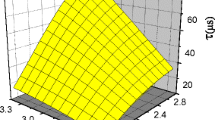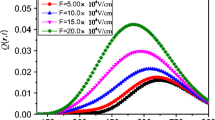Abstract
The Hamiltonian of a quantum rod (QR) with an ellipsoidal boundary is given after a coordinate transformation, which changes the ellipsoidal boundary into a spherical one. We obtain the eigenenergies and eigenfunctions of the ground and the first excited states of an electron, which is strongly coupled to the LO-phonon in a QR under an applied magnetic field by using the Pekar variational method. This system in QR may be employed as a two-level qubit. When the electron is in the superposition state of the ground and the first-excited states, we study the time evolution of the electron probability density. The relations of the probability density of electron on the temperature and the relations of the period of oscillation on the temperature and the cyclotron frequency of magnetic field are taken into consideration. The results show that the probability density of the electron oscillates in the QR with a oscillation period. It is found that the electron probability density and the oscillation period increase (decrease) with increasing temperature in lower (higher) temperature regime. The electron probability density increases (decreases) with increasing cyclotron frequency when the temperature is lower (higher). The oscillation period decreases with the increase of the cyclotron frequency.
Similar content being viewed by others
References
Peng X., Manna L., Yang W., Wickham J., Scher E., Kadavanich A., Alivisatos A.P.: Shape control of CdSe nanocrystals. Nature (London) 404, 59–61 (2000)
Kan S., Mokari T., Rothenberg E., Banin U.: Synthesis and size-dependent properties of zinc-blende semiconductor quantum rods. Nature (London) 2, 155–158 (2003)
Sek G., Podemski P., Misiewicz J., Li L.H., Fiore A., Patriarche G.: Photoluminescence from a single InGaAs epitaxial quantum rod. Appl. Phys. Lett. 92, 021901 (2008)
Sikorski C., Merkt U.: Spectroscopy of electronic states in InSb quantum dots. Phys. Rev. Lett. 62, 2164–2167 (1989)
Lorke A., Kotthaus J.P., Ploog K.: Coupling of quantum dots on GaAs. Phys. Rev. Lett. 64, 2559–2562 (1990)
Normura S., Kobayashi T.: Exciton-LO-phonon couplings in spherical semiconductor microcrystallites. Phys. Rev. B 45, 1305–1316 (1992)
Li S.S., Xia J.B.: Electronic structure and binding energy of a hydrogenic impurity in a hierarchically self-assembled GaAs/AlxGa1-xAs quantum dot. J. Appl. Phys. 100, 083714 (2006)
Li S.S., Xia J.B.: Effective-mass theory for coupled quantum dots grown on (11N)-oriented substrates. Chin. Phys. 16, 1–5 (2007)
Chi F., Li S.S.: Spin-polarized transport through an Aharonov-Bohm interferometer with Rashba spin-orbit interaction. J. Appl. Phys. 99, 043705 (2006)
Fedichkin L., Fedorov A.: Error rate of a charge qubit coupled to an acoustic phonon reservoir. Phys. Rev. A 69, 032311 (2004)
Li S.S., Xia J.B., Liu J.L., Yang F.H., Niu Z.C., Feng S.L., Zheng H.Z.: InAs/GaAs single-electron quantum dot qubit. J. Appl. Phys. 90, 6155 (2001)
Li S.S., Long G.L., Bai F.S., Feng S.L., Zheng H.Z.: Quantum computing. Proc. Natl. Acad. Sci. USA 98, 11847–11848 (2001)
Li W.P., Yin J.W., Yu Y.F., Wang Z.W., Xiao J.L.: The effect of magnetic on the properties of a parabolic quantum dot qubit. J. Low Temp. Phys. 160, 112–118 (2010)
Zhao C.L., Xiao J.L.: Temperature effect of strong-coupling magnetopolaron in quantum rods. J. Low Temp. Phys. 160, 209–218 (2010)
Li Z.X., Ding Z.H., Xiao J.L.: Temperature effect on magnetopolaronic vibrational frequency in an anisotropic quantum dot. J. Low Temp. Phys. 159, 592–600 (2010)
Xiang, S.H., Song, K.H.: Entanglement decoherence of two-particle entangled states in a noisy environment. Acta Phys. Sinica 55, 529–534 (2006) (in Chinese)
Li X.Z., Xia J.B.: Electronic structure and optical properties of quantum rods with wurtzite structure. Phys. Rev. B 66, 115316 (2002)
Author information
Authors and Affiliations
Corresponding author
Rights and permissions
About this article
Cite this article
Sun, Y., Ding, ZH. & Xiao, JL. The effect of temperature and magnetic field on a quantum rod qubit. Quantum Inf Process 12, 935–943 (2013). https://doi.org/10.1007/s11128-012-0436-1
Received:
Accepted:
Published:
Issue Date:
DOI: https://doi.org/10.1007/s11128-012-0436-1




